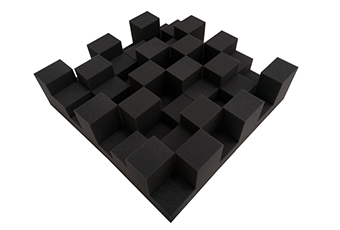
Purpose Designed Acoustic Solutions From Pro-coustix.com
Share
Call them acoustic panels, sound panels, acoustic baffles, or acoustic boards; If you are serious about audio content creation you will have come across them in some shape or form.. Whether it is the control of echoes & reverberation in meeting rooms, telemarketing space, or even your studio or auditoriums, acoustic panels are essential components in controlling sound quality.
The acoustic panel is a sound-absorbing foam panel that is employed to reduce echoes, , reverberation and residual internal noise bouncing around rooms so as to improve the overall quality of sound consumed or captured..
There a large number of acoustic solutions ranging from vertical & horizontal panels to absorb incident noise. These are made from a number of materials including mineral wool, fibre glass, polyester and polyether polyurethane foam as well as class 0 rated melamine resin foams. The choice of product will depend on the application, specific requirements e.g. fire rating or budget.
Pro-coustix presents sound block panels that help you get over all the sound transmission challenges you are facing as an audio professional. Melamine veneered MDF board fortified with Ultraflex high-density acoustic foam panel renders the product the ability to reduce sound ruckus by over 50%.
How do acoustic panels work?
Acoustic panels are generally more lightweight and softer as opposed to their sound-blocking equivalents. Owing to their flexible and open structure, they make great absorbers for sound waves and for preventing noise from reflecting off the surfaces such as ceilings, walls, and floors. Acoustic foam does this by transforming the energy of sound waves into heat and thereby lowering their potential to bounce around the room. 
The type of acoustic absorbent material you use and how it is installed has a role in further controlling the sound waves in a room. For instance, in recording studios, foam panels and tiles are integrated into the studio walls, which support lowering the echo and reverberation.
Acoustic foam presents a number of advantages over the fibre based absorbent solutions namely;
Acoustic foams are lighter and can be installed without to much worry about weight bearing features of walls and ceiling structures
Acoustic foam doesn’t release fibres into rooms improving the air quality in any workspace.
Acoustic foams are easier to cut into attractive functional spaces e.g. pyramid, raptor, razor and metro patterns which add to the aesthetic appeal of your workspace.
Finally Acoustic foam solutions are cheaper than their fibreglass equivalents making them an attractive solution for anyone tight on a budget.
Whatever solution you choose if you choose acoustic foam ensure you use a purpose engineered foam to maximise performance in your room.
We have previously published a detailed article on the various types of acoustic foam which can be found here
When do you need acoustic panels?
You would want to install acoustic panels of blue acoustic foam, red acoustic foam, or fireproof acoustic foam to mitigate the reveberation and bass boom in your room.. Acoustic panels help reduce sound waves reflecting off flat walls that add to the brightness in your workspace. Typically, to facilitate sound absorption in large rooms, acoustic tiles are installed on the largest surfaces like ceilings and walls..
If you are serious about improving the sound quality in your room we would highly recommend getting acoustic panels installed in your room. If you need any help working out how much you require you could use our foam calculator or contact us on 01442 899 294 and speak to one of our friendly advisors who will only be too happy to help.